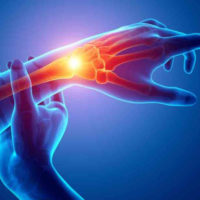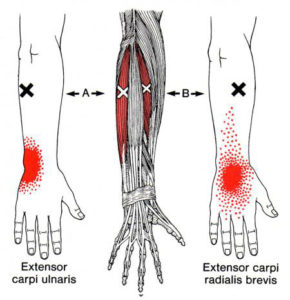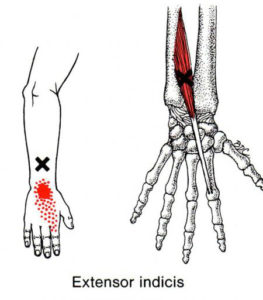 Decades ago, before I became a Myofascial Therapist, I routinely experienced pain when extending my wrists, making exercises like plank pretty difficult. Over time, it passed and returned occasionally, but the recurring episodes were brief and I didn’t investigate further.
Decades ago, before I became a Myofascial Therapist, I routinely experienced pain when extending my wrists, making exercises like plank pretty difficult. Over time, it passed and returned occasionally, but the recurring episodes were brief and I didn’t investigate further.
Two weeks ago the pain returned with a vengeance to top of my left wrist and did not abate so I had to figure it out. I thought it had been prompted by carrying something quite heavy with my wrist flexed for a long distance. The only confusing part was I would have expected more trouble with my wrist or finger flexors, rather than the muscles that extend the wrist and fingers. That might have been more like carpal tunnel syndrome, which primarily causes numbness, tingling and pain in the fingers.
Although there is a lot packed into a small space in the wrist, it is actually a pretty simple structure that contains NO muscles. I hadn’t fallen or otherwise wrenched it. I was confident there had been no fracture or damage to the bones. It also seemed unlikely I had damaged any of the ligaments of the wrist.

So, I focused on the muscles in the forearm. The tendons arising off these muscles allow us to flex and extend our fingers and our wrist. At first, I relied on my background knowledge of these muscles and worked higher up in the forearm, focusing on compression of Extensor Carpi Radialis Brevis while moving my wrist through its full range of motion. It helped a bit for the moment but no improvement day to day. And wow! The name of that muscle is a more than a mouthful. This is one of a group of muscles on the top of the forearm that extend the wrist to raise the hand up and back. The diagram shows the little finger side as well, but we’re focused on the right, thumb side…
In the meantime, someone came to see me with a virtually identical problem, lasting for three years and with no definite cause. This provided further motivation.
 Eventually, I decided review the musculature of the forearm. Great idea that I should have thought of earlier because I had forgotten about an important player – Extensor Indicis! This is a truly tiny muscle, difficult to palpate without extension of the index finger – then you can feel it quite clearly. Compression in this area had an intense, burning quality, but as I moved my wrist through its range of motion, I could tell it had
Eventually, I decided review the musculature of the forearm. Great idea that I should have thought of earlier because I had forgotten about an important player – Extensor Indicis! This is a truly tiny muscle, difficult to palpate without extension of the index finger – then you can feel it quite clearly. Compression in this area had an intense, burning quality, but as I moved my wrist through its range of motion, I could tell it had
So, out to do some yardwork and OUCH! The lawn edger I had picked up had just set it off again. This device has a handle designed such that you hold it from the top and the edge hangs down below. You hold the weight there and “aim” with the other hand. I had used this device for hours a day or two before the carrying the heavy object I thought triggerered my pain. I realized as soon as I picked it up that I had chosen to hold the weight in my left and aim with my right. I immediately switched hands, which was awkward at first.
I continued to use self-care techniques on my forearm and am continuing to see improvement. The moral of the story are two simple truths that we learn early on but sometimes forget:
- Myofascial treatment only works when you have assessed the cause correctly and treat the correct muscles
- No amount of treatment helps if you continue perpetuating the problem with the activity that triggered it to begin with
If you are having similar issues, you may find that a session or two to identify both the root cause and the tissues involved are helpful. I often explain that a big part of treatment is education, so that we are informed about why things hurt and what we can do about it. Sometimes even the most experienced therapists need a reminder too!
